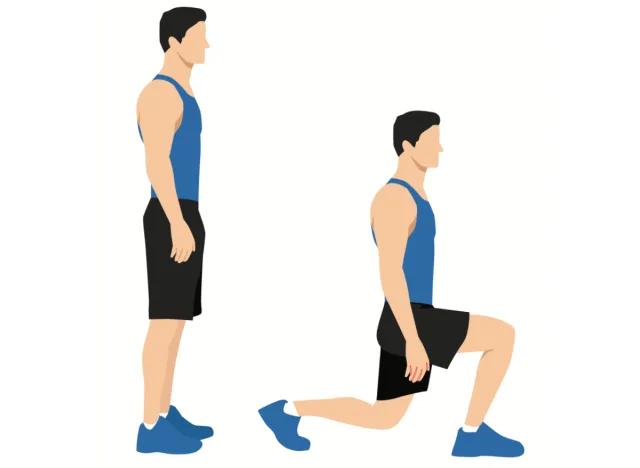We humans don’t like getting older. According to a 2021 OnePoll survey, more than half of the 2,000 American respondents have tried anti-aging hacks they found on YouTube, and another 40 percent report being so obsessed with aging that they’re willing to try anti-aging treatments that have zero scientific evidence supporting them. But seeking that elusive fountain of youth is a fool’s errand if you don’t exercise regularly. That’s why we spoke with Kyrie Furr, CPT, a certified personal trainer and performance coach with Barbend, who serves up her top bodyweight workout to slow down muscle aging.
Muscular aging, or sarcopenia, is a condition that naturally occurs as you age. According to a 2019 review, this decline in muscle mass and function decreases your mobility and spikes your risk of fall-related injuries as you age. Fortunately, research indicates that incorporating strength training (or resistance training) can combat muscle aging and keep your body thriving and active for many years to come.
“While there’s no magic workout or one-size-fits-all program to slow down muscle aging, incorporating a well-rounded bodyweight workout can be beneficial for maintaining muscle mass, strength, and overall health,” states Furr. “It’s essential to focus on exercises that target various muscle groups, promote flexibility, and improve cardiovascular fitness. Remember to consult a healthcare professional or fitness expert before starting a new workout routine, especially if you have pre-existing health conditions.”
Keep reading for the #1 workout to slow down muscle aging. Then, be sure to check out The Top 10 States That Are Most Likely To Become ‘Blue Zones,’ Study Reveals.
Warm-up

“Spend five to 10 minutes doing movements that will prepare your body for physical activity,” recommends Furr. “Movements that will get your heart rate up and help to mobilize your muscles include jumping jacks, arm circles, leg swings, high knees, and bodyweight squats.”
Pushups

The classic pushup is a powerhouse bodyweight exercise that engages multiple muscle groups, including the chest, triceps, and core.
Get into a plank position with your hands slightly wider than shoulder-width apart. Lower your body by bending the elbows until your chest almost touches the ground. Push back up to the starting position, keeping your body straight. Aim for four sets of as many reps as possible. Rest for 90 seconds between sets.
Air Squats

Air squats are a simple yet effective way to target the lower body, working the quadriceps, hamstrings, and glutes. Plus, squats promote functional movement by improving flexibility and stability.
To perform this movement, stand with your feet shoulder-width apart. Lower your body by bending your knees and pushing your hips back as if sitting in an imaginary chair. Keep your chest up and core engaged. Rise back up to the starting position, extending your hips and knees. Perform four sets of 15 to 20 reps with one minute of rest between sets.
Pull-ups

Pull-ups are a fantastic upper-body exercise primarily targeting the back, biceps, and shoulders. This move also improves grip strength, an essential component of functional movement as you age.
Hang onto a horizontal bar with an overhand grip, hands slightly wider than shoulder-width apart. Pull your body upward until your chin clears the bar. Lower yourself back down with control. Use a sturdy bar or assisted equipment if needed. Perform four sets of as many reps as possible with 90 seconds of rest between sets.
Inverted Rows

Inverted rows are often performed using a bar or suspension trainer. This movement helps improve posture and strengthens the muscles responsible for pulling movements while targeting muscles in the upper back and arms.
Set up a bar or suspension trainer at chest height. Lie underneath, grab the bar or handles, and keep your body straight. Pull your chest up toward the bar, engaging your back muscles. Lower your body back down, maintaining a controlled motion. Shoot for four sets of 12 to 15 reps, and rest for one minute between rounds.
Lunges

Lunges are a versatile bodyweight exercise that engages the quads, hamstrings, and glutes. This unilateral movement contributes to muscle balance, stability, and functional strength, making it an excellent addition to any bodyweight workout.
Stand with your feet hip-width apart and take one step forward, lowering your body until both knees are bent at a 90-degree angle. Push off with your front foot to return to the starting position. Repeat on the other leg. Complete four rounds of 15 to 20 reps per leg, resting for 90 seconds between sets.
Planks

This foundational core exercise engages the entire midsection, including the abdominals and lower back. Planks can boost strength, stability, and endurance, improving posture and preventing lower back issues.
To do them, start in a forearm plank position with your elbows directly beneath your shoulders. Keep your body straight from head to toe, engaging your core. Hold the position for 30 to 60 seconds. Repeat four times with one minute of rest between.
High-Intensity Interval Training (Cardio)

High-intensity interval training (HIIT) involves short bursts of intense, bodyweight-based exercises and brief rest periods. This form of cardio enhances cardiovascular fitness and boosts your calorie-burning potential by kickstarting your metabolism.
Choose a combination of bodyweight exercises such as jumping jacks, burpees, or mountain climbers, then perform each exercise at maximum effort for 20 to 30 seconds, followed by 10 to 15 seconds of rest. Repeat the cycle for three to five rounds. Rest for 90 seconds between each circuit.









